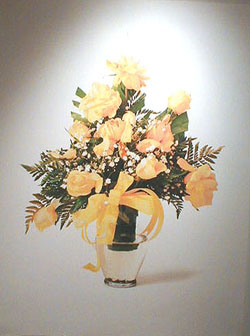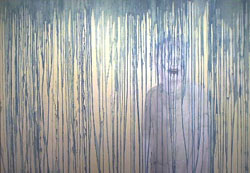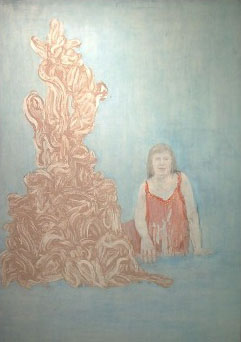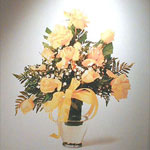Mixture, the new gallery owned by Dan Fergus of Brasil coffeehouse fame and directed by Paul Arensmeyer of Diverseworks fame, opened its inaugural show on Friday with flowers. Chuck Ramirez‘s Quarantine prints are a series of ultra-crisp photographs of cheap flower arrangements. Each is isolated on a painfully white background, with just enough of a faint shadow to give the whiteness depth.

Exquisite lighting and/or digital manipulation gives the pieces a hyper-real tactility; crinkly green florists” paper, velvety petals, and satiny ribbons yearn to be touched. About three times life size, each arrangement fills a 46 x 34″ piece of paper like a department store portrait; highly artificial, posed, and slightly tacky, but somehow pathetically sweet. I am told that the flowers are leftovers from hospitals, which I would rather not have known; it colors the pieces with all sorts of inevitable funerary/AIDS crisis/memorial meanings which make it impossible to look at them any other way, or to tell if those meanings would have emerged without outside help. Technically, each digital print is a tour de force of expensive, high-tech production, and I’m glad that Ramirez and Mixture had the guts to display them without glass, even at the rainy evening opening party.

True to its name, Mixture pairs Ramirez, from San Antonio, with Brad Rogers, from Portland, Oregon. Like Ramirez, Rogers photographs flowers, collaging together standard machine prints, then sanding, taping, stitching and mounting them into pleasant but forgettable quilt-like patterns.
Patricia Hernandez’s Phrases for Painting at James Gallery, which also opened Friday, is a bait-and-switch scam: the invitation depicts the only non figurative piece in the show! All but one of Hernandez paintings contrasts spills, pools or mounds of squishy paint with a ghostly, partially erased figures. The invite is right: the abstract bits are the best; burnished, dripped, scuffed and finger-painted, they have a heavy dignity. The abrupt juxtaposition of such portentous painting with stilted, sentimental figures gives the work a bizarre folk-art directness.
At times the figures and the blobs interact to create a narrative as in integrity in some uncertainty, where an exasperated woman is confronted by a roiling turquoise stain. Is she going to have to clean it up? Likewise, in if such moments appear unresolved, for now it doesn’t matter a frumpy woman in a housedress sits resignedly next to a huge pile of shit.
In two “happy” pieces, something like it was here before and to know how much of your you are the connection between blob and blob goddess is more ambiguous and less funny. Blowsy women sit amid flowerlike dabs as if in a meadow; each face has the stiff specificity of a portrait painted from a photograph. Hernandez’s Hallmark-card expressionism is schmaltzy, but sincere. It’s done with such unaffected honesty that it can be seen as a penetrating insight into way conventionalized feelings replace real ones.
All images are courtesy the artists and galleries.
Bill Davenport is an artist and writer and was one of the first contributors to Glasstire.





